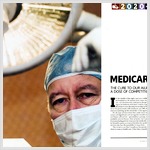
Dr. Brian Day
@DrBrianDay 
- Past President Canadian Medical Association
- Past President Arthroscopy Association of North America
- Honourary Associate Professor University of British Columbia
- 2014 Doctors of BC Don Rix Leadership Award


The cure to our ailing system: a dose of competition.
By Erin Pooley
It's the middle of the night, and your toddler is up with a bad fever. The nearest hospital is a 30-minute drive away, your spouse is out of town - with the car - on a business trip, and you've also got two other young children screaming in the bedroom next door. Luckily, a quick phone call will bring a licensed physician to your doorstep in less than an hour. It won't cost you a cent, either, since the government will reimburse you 70% of the cost of the visit, with private insurance picking up the remainder of the approximately $80 tab.
It's the type of innovation that could mean improved access, better health outcomes and significant cost savings for Canada's medical system. But this 24/7 medical house-call service - provided by a private company called SOS Médecins - is available only in France. Here at home, the Canada Health Act prevents patients from purchasing private insurance for medically necessary services already insured by the public purse; provinces that allow for-profit practitioners to bill for these same services also face the possibility of steep fines.
This is not to say that Canadians fare poorly against their global counterparts when it comes to health care. Other than a handful of medical expenses not covered by provincial governments - including most outpatient drugs, dental and vision services - they have enjoyed universal access to physician and hospital care since 1972, when the provinces and territories agreed to share costs with the federal government. On the World Health Organization's most recent global health-care ranking, Canada placed 30th, seven spots ahead of the United States and 161 spots ahead of last-place Sierra Leone. Health-care spending as a share of gross domestic product is also lower in Canada than in the United States, Switzerland, Germany or France, which each allocated 10.5% or more of GDP to health care in 2004, compared with Canada's 9.9%. Per capita spending in Canada is just more than half, or US$3,165, of what it is in the United States.
All good, sure. But there's a price to be paid. Managing overall costs has meant managing individuals' access to care. The result? Overcrowded emergency rooms, growing wait lists for services ranging from hip replacement to heart surgery, and less access to life-saving drugs for those who need them most. Some Canadians have opted to travel to places such as India or China for surgery in private hospitals; others have mortgaged their lives away to purchase drugs not covered by provincial formularies.
It's not going to get any better, either. As the boomer generation ages - chronic illnesses such as diabetes, heart disease and stroke threaten to shave more than US$8.5 billion from Canada's national income between 2005 and 2015 - the strain on our health-care system will likely get worse. A report by the Fraser Institute, a Vancouver-based conservative think-tank, predicts that by 2020 public health spending in six of 10 provinces will consume more than half of revenues from all sources; that figure will climb to two-thirds of public revenues by 2035, and 100% by 2050.
Unfortunately, the health of Canadians isn't the only thing that will suffer. The more money provinces and territories spend on health care, the less they will have available for other areas such as education, infrastructure, and research and development. Some policy commentators warn that productivity will continue its downward spiral, our standard of living will decline, and innovation will decrease.
A growing chorus of experts say the only prescription for our ailing system involves injecting a healthy dose of competition into a sector that has traditionally been immune to the market forces that drive most other areas of our economy. That would mean sacrificing the sacred cows of medicare - namely, who delivers and who pays for health care in this country.
Competition remains a dirty word for many Canadians, who view universal health care as a fundamental right, not a commodity. It is worth noting, however, that Canada is one of only a handful of countries under the Organisation for Economic Co-operation and Development (OECD) umbrella that has maintained such a firm grip on its public health-care monopoly. With the exception of a few hundred privately funded surgical, cosmetic and medical-imaging clinics located mainly in British Columbia and Quebec, health-care delivery in Canada has remained largely in the public domain. Fears of two-tier medicine - including the migration of doctors and nurses to the more lucrative for-profit sector, lack of cost containment in a private system, and the gradual delisting of medically necessary services currently funded by the provinces - have helped maintain the status quo. After all, few would want to see Canada move toward a privatized U.S.-style model of health care, where about 50 million people are without medical insurance.
"Americanizing" our system may not be an answer. But critics of Canada's existing medicare model say we should be considering a mix of health-care solutions from other countries. In places such as France, Switzerland and Germany - where private financing and for-profit providers play a greater role - wait times for elective surgeries are not an issue.
Dr. Brian Day, Canada's unofficial champion of medicare reform and founder of this country's largest for-profit surgical clinic - Vancouver's Cambie Surgery Centre - is unabashed in his criticism of the Canadian system. "We're the only OECD country that gives its hospitals their funding upfront and says, ‘Treat patients, and let's see how you're doing at the end of the year.' That's a perverse form of funding," says the recently installed president of the Ottawa-based Canadian Medical Association. He suggests an alternative: "Imagine, for example, that you were to show up at an emergency room. If you end up walking out because the wait was too long, the hospital doesn't get your money. It's that simple."
Instead of paying hospitals - which consume the lion's share of Canada's $148 billion in annual health-care spending - on a block basis, Day would like to see "patient-focused funding," where money follows patients throughout the system, treating them as a source of revenue to a hospital rather than a cost. Pay-for-performance programs, which would reward institutions based on the number of people treated, the procedures performed and the timeliness of care, are another way to introduce more market-based forces. So is opening up the market to additional for-profit health-care providers, many of whom have vowed to offer less expensive and more innovative ways to treat Canadians.
France's SOS Médecins is a good example of what could be done. Since it was founded more than 40 years ago, this private medical house-call service has emerged as a case study in successful public-private health-care partnerships. Each year, SOS Médecins' 1,000 doctors make about 2.5 million home visits across France, delivering everything from emergency care to less urgent medical checkups. "Patients don't wait one, two, three, four or five hours in the emergency room," says Serge Smadja, president of SOS Médecins Paris. "It also costs less because when a patient goes to hospital, the system has to pay for the doctor, the bed and any other health-care professionals involved in their care."
The model is simple: by allowing both public and private providers to wrestle over the government's health-care dollar, both types of organizations would face the same incentives for efficiency - and the best provider would win. "All the government has to say is, ‘We'll fund it, but we want the best service at the lowest price,'" says Brett Skinner, director of health and pharmaceutical policy research at the Fraser Institute.
It's a formula that makes sense for Colin Patey, a Canadian expat and chief executive of Interhealth Care Services (UK) Ltd. The company's Toronto-based parent - InterHealth Canada - manages public hospitals in the United Kingdom and the United Arab Emirates, and was originally conceived as a way to export Canada's considerable intellectual and management expertise in health care.
Ironically, InterHealth can't provide publicly funded services here at home, due to heavy resistance from the Canadian government when it comes to giving for-profit providers a greater piece of the health-care pie. But this hasn't stopped the company from going gangbusters overseas. In 2005, the British government awarded Interhealth a five-year £148-million ($298.4-million) contract to build and operate one of the country's first privately managed, publicly owned orthopedic surgery hospitals. The Cheshire & Merseyside NHS Treatment Centre opened on June 1, 2006, and it now performs 5,000 to 7,000 elective orthopedic surgeries annually. Interhealth also has health-care management contracts in Dubai and Kuwait.
Britain's National Health Service has cut waiting lists dramatically, partly by contracting out thousands of elective surgeries each year to such private-care hospitals as Patey's. Patients are given free alternatives to the government-run system and can choose between public or publicly funded private facilities based on how each performs against competitors. "We have to report religiously each month with some 26 key performance indicators - any breach of any of these can cause a joint service review with the local contract management group," says Patey. "Competition drives pricing down, efficiency up, and seeks new ways of delivering the same product with the same level of quality but at a lower price. It forces us to look at both the combination of capital and operating expenses, new technology, innovation and labour."
Dr. David Gratzer is a Canadian-born physician and author, and is senior fellow at the Manhattan Institute's Center for Medical Progress, a New York-based think-tank. He suggests taking the concept of public-private health-care competition one step further. Why not, Gratzer asks, open Canada's borders to medical providers from around the world - making for a sort of free trade in health care? Patients would be able to access a much greater pool of medical expertise; meanwhile, governments could reduce wait times and competition would help to drive costs down. "If some businessman can operate an MRI and give me as high quality an MRI as a public hospital at half the cost, it's a win-win," says Gratzer. "I don't care if the company that owns that MRI is Swedish or Canadian or even American. It's irrelevant. The question is whether we can give patients better care."
Ensuring better care - not profit - is the driving concern behind reforms to Canada's system. Promoting the health and well-being of all its citizens, regardless of financial means, is one of the best economic choices any government can make. "People who are healthier are generally a lot more productive - they add a lot to the growth of the economy," says Skinner. "But by running a public insurance system that bans private payment, we've created a demand for these things that is unmet."
By bringing costs closer to Canadians - whether through private medical insurance or out-of-pocket expenses - Skinner believes the government could shift some of the burden of financing to the private sector, while continuing to provide subsidies to low-income earners. (Today, about 70% of total Canadian health expenditures come from the public purse; the remainder come from private sources such as employers.)
Instead of having to pay for health care through higher taxes, Skinner believes Canadians should become more active participants in the financing of their own care. It's a controversial concept - but one Canadians seem increasingly willing to consider. In 2005, a landmark Supreme Court decision known as the Chaoulli case ruled that preventing Quebecers from purchasing private insurance "while failing to deliver health care in a reasonable manner" was a violation of their charter rights. Two similar lawsuits are under way in Ontario and Alberta. And in late July, the Canadian Medical Association endorsed the purchase of private insurance that would be used in the event the publicly funded medical system exceeds wait-time guarantees.
A parallel private system would create more choice for patients, return people to health faster and could even end up providing speedier access to care in the public system, by cutting down on waiting lists. "It would work exactly the same way that public education does," says Skinner. "You've still got to pay your taxes for the public system. But if you don't want to send your kids there, that's fine."
An increased role for the private sector in health-care financing does not come without risks. Lack of cost containment could mean individuals without the ability to pay slip through the cracks, as has occurred in the United States. In some cases, countries with multiple payers are among those with the highest health expenditures. And yet, in several OECD nations where co-payments and private insurance are the norm, universality of care has been maintained. In France - ranked No. 1 on the World Health Organization's health-care list - the sizable presence of the private sector has led to greater freedom of choice with very little impact on access. In Germany (ranked 25th), people with higher incomes can opt out of the public insurance system, which still provides a high level of service to those who remain. Patients in Sweden (23rd) are required to pay user fees toward medical expenses ranging from emergency room visits to physician checkups. And in Switzerland (20th), private medical insurance is compulsory and tightly regulated to ensure open enrolment, community-rated premiums and a standardized basket of benefits. "They have modern hospitals, no wait times, full access to new medicines and technologies, and very highly trained medical professionals in adequate numbers," says Skinner. "They spend a little bit more than we do per capita, but they get way more for their money because it's more efficient."
There is little question that significant change - and sacrifice - will be required to ensure the continued health of Canada's medical system. In the meantime, we should also be preserving those elements of the Canadian system with the greatest promise of delivering more bang for our health-care buck.
National programs in chronic disease management are a start. Unless we devote more resources to helping people self-manage debilitating illnesses such as diabetes, asthma and arthritis, our system will buckle under the weight, says Michael Decter, former Ontario deputy minister of health and co-author of Navigating Canada's Health Care: A User Guide to Getting the Care You Need.
Accelerating the health care system's investment in information technology and electronic patient records - which pales in comparison to that of most other OECD countries - will also help ensure administrators have the information they need to make critical decisions on the progress of wait-time and prescription-drug management initiatives.
Finally, a renewed focus on developing sophisticated diagnostic tools will help eliminate waiting lists for expensive and complicated imaging technologies such as MRIs. Imagine, for example, that instead of having to wait months to undergo the procedure in hospital, your doctor could perform the test in his or her own office using a smaller, less expensive imaging tool. "There is a way to innovate ourselves out of the so-called unsustainability crisis," says Decter. "It's a matter of finding more value for each health-care dollar spent."
Since most experts agree that costs aren't likely to decline significantly in the coming years, it's time for governments to make some difficult decisions about how to spend more efficiently. In short, they need to experiment. Ignoring the many different options out there will eventually put Canada at a competitive disadvantage with those nations that can rein in their own rising costs through hybrid health-care delivery, greater private sector financing and innovation in chronic disease management, information technology and diagnostics.
As the Fraser Institute's Skinner points out, there is a $2-trillion-plus health-care industry waiting to be accessed by Canadian health-care providers - right next door, in the United States. By finding ways to free up resources at home, he believes that we could take advantage of the state-of-the-art medical technology and expertise that already exist here in Canada. Instead of being a drain on federal and provincial coffers, the health-care system could, in effect, become a net generator of revenue, boosting the GDP and reducing the possibility of future tax hikes.
"If we had no wait lists in Canada, our hospitals could open up on weekends or nights to treat patients," adds the CMA's Day. "Instead of medical tourism where Canadians are going to India and China, it should be the other way around. It could be our biggest industry."
Medicare Inc.: as a way to keep the health care system off life support, it is an idea worth embracing.